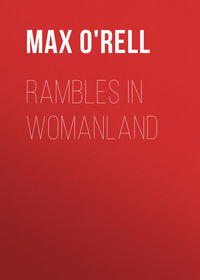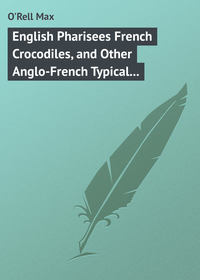 полная версия
полная версияFriend Mac Donald
Porridge! it is the secret of the Scot's success. Try to compete with a man who can content himself with porridge, when you must have your three or four meals a day and animal food at two of them.
It is porridge that gives a healthy body, cool head, and warm feet;
Porridge promotes the circulation of the blood;
It is porridge that calms the head after the libations of overnight.
It is porridge that keeps the poor man from ending his days in the Union.
It is porridge that helps the son of the humble peasant to aspire to the highest career, in allowing him to live on a scholarship at the University;
It is porridge that makes such men of iron as Livingstone and Gordon;
And, above all, it is porridge that puts the different classes in Scotland on a footing of equality once a day at least, and thus makes of them the most liberal-minded people of Great Britain.
The national drink of Scotland is Scotch whisky.
The Scotch will tell you that Irish whisky is no good; the Irish will tell you that Scotch whisky is simply detestable. I have tasted both, and, having no national prejudice on the point, have no hesitation in saying that there is nothing to choose between them: both are horrible.
Whisky may easily be obtained by dissolving a little soot in brandy. As the coal-smoky taste is much more pronounced in the Scotch whisky than in the Irish, I conclude that, in the latter, the dose is smaller.
They say that of all alcoholic liquors whisky is the least injurious. By "they" must be understood all the good folks who cannot do without this beverage. There must, however, be truth in it, or Scotland and Ireland must have been depopulated long since. And, as we know the Scotch generally live to a good old age, and centenarians are not rare in the Land o' Cakes, if whisky be a poison, it must be a slow one – a very slow one.
The prettiest anecdote, in Dean Ramsay's Reminiscences, relates to whisky, and I cannot refrain from quoting it.
An old Scotch lady had just sent for her gardener to cut the grass on her lawn.
"Cut it short," she said to him; "mind, Donald, an inch at the bottom is worth two at the top."
Always the same way of speaking in moral sentences so common in Scotland.
The work done, the good lady offered Donald a glass of whisky, and proceeded to pour it out, but showed sign of stopping before the top was reached.
"Fill it up, ma'am, fill it up," said the shrewd-witted fellow, "an inch at the top is worth twa at the bottom."
CHAPTER XXV
Hors-d'œuvre. – A Word to the Reader and another to the Critic. – A Man who has a right to be proud. – Why?
Here I pause, dear Reader.
An idea has just come to my head, and for fear it might be lonely there, I will impart it to you without delay.
Now, to come at once to the sense of the matter, will you allow me for once – for once only – to pay myself a compliment that I think I well deserve? It is the word "Ireland," which I have just written in the preceding chapter, that makes me think of addressing sincere congratulations to myself. Forgive me for this little digression, it will relieve me.
I have written two books on England, a third on the relations between England and France, and I shall soon have finished a volume of recollections of Scotland.
How many times I have had to write the words "England" and "Ireland," I could not say; but I affirm that I have not once – no, not once – spoken of "Perfidious Albion" or the "Emerald Isle."
"Indeed!" and "What of that?" you will perhaps exclaim.
Well, whatever you may say, I assure you that if ever a man had a right to feel proud of himself, I have.
More than once have I been tempted, once or twice I have had to make an erasure, but I am the first who has triumphed over the difficulty.
Come, dear Critic, if thou wilt be amiable, here is an occasion. Admit that a Frenchman, who can write fourteen or fifteen hundred pages on the subject of England, without once calling her "Perfidious Albion," is a man who is entitled to thy respect and thy indulgence for the thousand and one shortcomings of which he knows himself to be guilty.
There, I feel better now. Let us now go and see Donald's big touns.
CHAPTER XXVI
Glasgow. – Origin of the Name. – Rapid Growth of the City. – St. Mungo's Injunction to Donald. – James Watt and the Clyde. – George Square. – Exhibition of Sculpture in the open Air. – Royal Exchange. – Wellington again. – Wanted an Umbrella. – The Cathedral. – How it was saved by a Gardener. – The Streets. – Kelvingrove Park. – The University. – The Streets at Night. – The Tartan Shawls a Godsend. – The Populace. – Pity for the poor little Children. – Sunday Lectures in Glasgow. – To the Station, and let us be off.
If, as Shelley has said, "Hell is a city much like London," Glasgow must be very much like the dungeon where Satan shuts up those who do not behave themselves.
The word "Glasgow" is of Celtic origin, and, it appears, means Sombre Valley.
The town has not given the lie to its name.
I have travelled from the south of England to the north of Scotland; I have seen every corner of the great towns, and I do not hesitate to give the palm to Glasgow: it is the dirtiest, blackest, most repulsive-looking nest that it was ever given to man to inhabit.
I am bound to say that the Scotch themselves, so justly proud of their old Scotland, dare not take it upon themselves to defend Glasgow: they give it over to the visitor, not, however, without having added, as a kind of extenuating circumstance:
"There is money in it."
At the time of the Reformation, Glasgow was but an insignificant little town with five thousand inhabitants. At the commencement of this century it contained about eight thousand. To-day it is the most important city of Scotland, a city which holds, including the suburbs, very nearly a million souls, tortured by the passion for wealth or by misery and hunger.
If the importance of the place is recent, the place itself dates back more than thirteen centuries. It was indeed in 560 that Saint Mungo founded a bishopric there, and no doubt, to try the faith of Donald, whom he had just converted to Christianity, he said to him, as he put an umbrella into his hands with strict injunctions never to part with it:
"For thy sins, Donald, here shalt thou dwell."
Glasgow is the home of iron and coal. Coal underground, coal in the air, coal on people's faces, coal everywhere!
There rise thousands of high chimneys, vomiting flames and great clouds of smoke, which settle down on the town and, mixing with the humidity of the streets, form a black, sticky mud that clogs your footsteps. No one thinks of wearing elastic-side boots. They would go home with naked feet if they did. Glasgow people wear carmen's boots, strongly fastened on with leather laces.
I assure you that if you were to fall in the street, you would leave your overcoat behind when you got up.
The neighbourhood of the sea and the Clyde has been, and still is, a source of prosperity and opulence to the town; and here it behoves me to speak of the Scotch energy, which has made of this stream a river capable of giving anchorage to vessels drawing twenty-four feet of water.
In 1769, the illustrious James Watt was directed to examine the river. At that time small craft could scarcely enter the river even at high water. Watt indeed found that, at low tide, the rivulet – for it was nothing else – had but a depth of one foot two inches, and at high tide never more than three feet three inches.
To-day you may see the largest ironclads afloat there. This gigantic enterprise cost no less than £10,300,000.
It was on the Clyde that Henry Bell, in 1812, launched the first steamboat. Since then the banks of the Clyde have been lined with vast shipbuilding yards, which turn out from four to five hundred vessels a year.
Glasgow always had a taste for smoke. Before the war of American Independence, this town had the monopoly of the tobacco commerce. Colossal fortunes were realised over the importation of the Virginian weed in the end of the last century. At present Glasgow trades in coal, machinery, iron goods, printed calico, etc.
The Glasgow man has been influenced by his surroundings. The climate is dull and damp, the man is obstinate and laborious; the ground contains coal and iron for the Clyde to carry to sea, and so the man is a trader.
And, indeed, what is there to be done in Glasgow but work? Out-of-door life is interdicted, so to speak; gaiety is out of the question; everything predisposes to industry and thought. People divide their time between work and prayer, the kirk and the counting-house; such is life in Glasgow.
And now let us take a stroll, or rather let us walk, for a stroll implies pleasure, and I certainly cannot promise you that.
The most striking feature of Glasgow is George Square. It is large, and literally crowded with statues, a regular carnival. It looks as if the Glasgow folks had said: "We must have some statues, but do not, for all that, let us encumber the streets with them; let us keep them out of the way in a place to themselves. If a visitor likes to go and look at them, much good may it do him." At a certain distance the effect is that of a cemetery, or picture to yourself Madame Tussaud's exhibition à la belle étoile.
When I say à la belle étoile, it is but a figure of speech in Glasgow.
In this exhibition of sculpture, I discover Walter Scott, Robert Burns, David Livingstone, James Watt, Prince Albert, Queen Victoria, Thomas Campbell, and Sir Robert Peel. Some are on foot, some on horseback. There are none driving, but there is Scott who, in the centre of this Kensal Green, is perched on the summit of a column eighty feet high. It is enough to make the tallest chimney of the neighbourhood topple over with envy. By dint of a little squeezing, it would be easy to make room for a dozen more statues.
In Queen's Street, quite close to George Square, we find the Royal Exchange – an elegant building in the Corinthian style – in front of which stands an equestrian statue of gigantic dimensions.
It is Wellington – the inevitable, the eternal, the everlasting Wellington.
Oh, what a bore that Wellington is!
This statue was erected at the expense of the town for a sum of £10,000.
Wellington will never know what he has cost his compatriots.
Let us go up George Street, turn to the left by High Street, towards the north-east, and we shall come to the Cathedral, the only one which the fanatic vandalism of the Puritans spared. I was told in Scotland that this is how it escaped. The Puritans had come to Glasgow in 1567 to destroy the Cathedral of Saint Mungo. But a gardener, a practical Scot of the neighbourhood, reasoned with them in the following manner:
"My friends, you are come with the meritorious intention of destroying this temple of popery. But why destroy the edifice? It will cost a mint of money to build such another. Could not you use this one and worship God in it after our own manner?"
The Puritans, who were Scots too, saw the force of the argument and the cathedral was saved.
The edifice is gothic, and very handsome. I recommend especially the crypt, under the choir. The windows are most remarkable.
Around the cathedral is a graveyard containing fine monuments. I read on a tablet, put up in commemoration of the execution of nine covenanters (1666-1684) the following inscription, which shows once more how they forgive in Scotland. Here is the hint to the persecutors:
"They'll know at resurrection dayTo murder saints was no sweet play."Let us return down High Street as far as Argyle Street, the great artery of Glasgow.
After a few minutes' walking, we come to Buchanan Street, the fashionable street of Glasgow – I mean the one which contains the fashionable shops, the Regent Street of this great manufacturing city. The houses are well-built, I do not say tastefully, but solidly. This might be said indeed of the whole town: it is dirty, but substantial. Let us push on to Sanchyhall Street, and there turn to the west. We presently come to the park of Kelvingrove, undulating, well laid out, and surrounded with pretty houses: it is the only part of Glasgow which does not give you cold shivers. Among the well-kept paths, flowerbeds, and ponds, you forget the coal-smoke for awhile. At the end of the park runs the Kelvin, a little stream which you cross to get to Gilmore Hill, on the summit of which stand the buildings of the university. The interior of these buildings is magnificent.
The Bute Hall is one of the finest halls I ever saw: 108 feet long, 75 broad, and 70 high. A splendid library and all the comfortable accessories, which they are careful to supply studious youth with in this country. The university cost more than half-a-million. With the exception of a few other parks – which, however, cannot be compared to those of London – there is nothing more to be seen in Glasgow, and if your business is transacted, go to your hotel, strap your luggage, and be off.
But if you prefer it, we will arm ourselves with umbrellas and return to the streets, and see what kind of people are to be met there.
That which strikes one at a first visit, is that from five in the afternoon almost every respectable-looking person has disappeared, and the town seems given over to the populace. Like the City proper in London, Glasgow is only occupied by the superior classes during business hours. From four to five o'clock there is a general stampede towards the railway stations. The employé, who earns two or three hundred a year, has his villa or cottage in the suburbs. The rich merchant, the engineer, the ironmaster, all these live far from the city.
The streets of Glasgow, from six or seven in the evening, are entirely given up to the manufacturing population – the dirtiest and roughest to be seen anywhere, I should think.
I have seen poverty and vice in Paris, in London, in Dublin, and Brussels, but they are nothing to compare to the spectacle that Glasgow presents. It is the living illustration of some unwritten page of Dante.
"But there is money in Glasgow."
The lower-class women of London do wear a semblance of a toilette: fur mantles in rags, battered, greasy hats with faded flowers, flounced skirts in tatters – an apology for a costume, in short.
But here, there is nothing of all that. No finery, not even a hat. The tartan seems to take the place of all.
The attributions of this tartan are multiple. It is as useful to the women of the lower classes in the great Scotch towns as the reindeer is to the Laplander.
This tartan serves them as a hood when it is cold; as an umbrella when it rains; as a blanket in winter nights; as a mattress in summer ones; as a basket when they go to market; a towel when they do their own and their children's dry-polishing; a cradle for their babies, which they carry either slung over their back, Hottentot fashion, or hanging in front, like the kangaroos. When poverty presses hard, the tartan goes to the pawnbroker's shop, whence it issues in the form of a sixpence or a shilling, according to its value. After living in them they live on them, and so these useful servants pass from external to internal use, and appease the hunger or thirst of their owners for a day or two. A very godsend this tartan, as you see.
A Glasgow police inspector told me that, having one day to make a search at a pawnbroker's in the town, he had found more than fifteen hundred of these shawls on the premises. "Many of those poor borrowers are Irish," he said. Did he say this to pass on to a neighbour that which seemed to him a disgrace to his own country? In any case, it is a fact that there are a great number of Irish in Glasgow.
No doubt poverty, with its accompaniments of shame and vice, exists in all great cities; but here it has a distressing aspect that it presents in no other country. The Arab beggar makes one smile as he majestically drapes around him his picturesque, multicoloured rags; the lazzarone, lying on the quay of Naples under the radiant Italian sky, is a prince compared to the wretch who drags out his existence in the dirty streets or garrets of Glasgow.
"But there is money in Glasgow."
In Paris, the newspapers are sold in shops or pretty kiosks kept by clean, tidy, respectable women. In London and other large English towns, the papers are cried in the streets by low-class men and boys. In Glasgow and Edinburgh the work is done by ragged children, who literally besiege you as you walk the streets: poor little girls half-naked, shivering, and starving, with their feet in the mud, try to earn a few pence to appease their own hunger, or, perhaps, furnish an unnatural parent with the means of getting tipsy. Others have a little stock of matches that they look at with an envious eye, one fancies, as one thinks of Andersen's touching tale.
Oh, pity for the poor little children!
In a country so Christian, so philanthropic, can it be that childhood is abandoned thus? Asylums for the aged are to be seen in plenty, and is not youth still more interesting than age, and must it needs commit some crime before it has the right to enter some house of refuge?
I cannot tell you how sad the sight of those poor little beings, forsaken of God and man, made me feel.
But how shall I describe my feelings when, having drawn the attention of a Scotchman who was with me to one of these pitiful little creatures, I heard him say:
"Do not stop, the immorality of those children is awful."
No, it is not possible; it must be a bad dream, a hideous nightmare.
"It is a fact," said my companion, who knows Glasgow as he knows himself.
"But there is money in it."
It seems incomprehensible that these children should not be reclaimed, still more incomprehensible that no one seeks to do it. The money spent in statues of Wellington would more than suffice, and the Iron Duke would be none the worse off in Paradise.
Yes, this is what may be seen in Glasgow, in that city so pious, that to calm the feelings of some of the inhabitants, the literary and scientific lectures which used to be given to the people on Sunday evenings in Saint Andrew's Hall have had to be discontinued.
Heaven be thanked, Glasgow is not Scotland, and we can go and rejoice our eyes in Edinburgh, Aberdeen, Braemar, and elsewhere, and admire the lakes and the blue mountains.
CHAPTER XXVII
Edinburgh – Glasgow's Opinion thereof, and vice versâ. – High Street. – The old Town. – John Knox's House. – The old Parliament House. – Holyrood Palace. – Mary Stuart. – Arthur's Seat. – The University. – The Castle. – Princes Street. – Two Greek Buildings. – The Statues. – Walter Scott. – The inevitable Wellington again. – Calton Hill. – The Athens of the North and the modern Parthenon. – Why did not the Scotch buy the ancient Parthenon of the modern Greeks? – Lord Elgin. – The Acropolis of Edinburgh. – Nelson for a Change.
A railway journey of an hour and ten minutes transports you from darkness into light. You leave Glasgow in gloom, wrapped in its eternal winding-sheet of fog and mud, and you arrive at Edinburgh to find clean streets, pure air, and a clear beautiful sky. Such at least was my own experience, six times repeated. The prospect delights the eyes and heart; your lungs begin to do their work easily; you breathe freely once more, and once more feel glad to be alive.
You alight at Waverley Station in the centre of the city. You cannot do better than go straightway and take up your quarters at the Royal Hotel, Princes Street, opposite the gigantic Gothic monument erected to Walter Scott. Ask for a room looking on the street. Take possession of it without delay, and open your window: the sight that will meet your gaze is truly enchanting. At your feet, the most elegant street imaginable. No houses opposite: only large gardens, beautifully kept, sloping gracefully away to the bottom of a valley, whence the ground rises almost perpendicularly, bearing on its summit houses of a prodigious height. It is the old town of Edinburgh, where everything will bring back memories of Mary Stuart and the novels of Scott. On the right the famous castle perched on a sheer rock nearly four hundred feet high; the whole bathed in a blue-grey haze that forms a light veil to soften its colouring and contour. It is impossible to imagine a more romantic sight in the midst of a large modern city.
Whether your tastes be archæological or artistic, you will be able to satisfy them in one of the two towns of Edinburgh, the old city to the south, or the modern town to the north.
The Glasgow folks say there is not much money made in Edinburgh, and speak of the place with a certain contempt, which the Edinburgh people return with interest.
It is always amusing to hear the dwellers in neighbouring towns run each other down: Manchester and Liverpool, Brighton and Hastings. The nearer the rival towns are to each other, the livelier and more diverting is the jealousy. Go and ask a Saint-Malo man what he thinks of Saint-Servan, and vice versâ!
"Ah! you are going to Edinburgh," the Glasgow people say to you; "it is full of snobs, who give themselves airs and are as poor as Job. Ours is a substantial place, sir. We've no time to waste on nonsense here; we go in for commerce and manufactures."
"Ah! you have just come from Glasgow," say the Edinburgh people. "What do you think of the illiterate parvenus that are for ever rattling their money bags? You will find no worship of the golden calf here; we cultivate the beautiful, and go in for science and literature, not manufactures; our town is essentially one of learning."
This is true. Edinburgh is one of the most important intellectual centres of the world, and its celebrated university, and learned societies, have justly earned for it the appellation of "the Athens of the North," a name which this unique city deserves also on account of its natural features, the style in which it is built, and the numerous monuments it possesses.
Edinburgh has a population of 350,000 inhabitants, including the sentry at Holyrood Palace.
According to d'Anville, the city stands on the site of the Roman station of Alata Castra. Towards the year 626 the fortress became the residence of Edwin, King of Northumbria, who gave it his name.
The old city was entirely destroyed by fire in 1537. That which now bears the name of old town dates from the end of the sixteenth century and the beginning of the seventeenth.
The modern part of Edinburgh was begun at the close of last century, and the handsomest streets are of a quite recent date.
A tout seigneur tout honneur. Let us commence our inspection by a visit to Holyrood Palace.
I should like to transform this little volume into a guide-book, and give you the history of all the houses we are passing, as we go through the old town, for almost every one has its history. There on your left is the house of John Knox, with its flight of steps, its overhanging stories, and, over the door, the inscription, "Love God above all, and your neighbour as yourself." Here is the house where Cromwell decided on the execution of Charles I.; there Hume and Smollett wrote history.
At the end of Canongate, the prolongation of High Street, we come out on a large open square. The palace of Holyrood is before us.
Standing in a hollow, and surrounded by high hills, the aspect of the palace is most sombre. From the moment you cross the threshold, a thousand sad thoughts assail you. You are in the home of Mary Stuart. Everything speaks to you of her. Her sweet, tragic face, her noble presence, her thoughtful brow – you see all again in these halls instinct with her souvenir. They haunt the place as they still haunt the memory of the Scotch. In spite of her bigotry, in spite of all the crimes historians have imputed to her, the Scotch cherish her memory, think only of her misfortunes and sufferings, and will not hear you speak of her with anything but respect. One may easily imagine the ascendency which this woman must have had over those who came in contact with her.
But let us go in, and first we must get our sixpences ready; for in this country, where l'hospitalité se donne, you must pay everywhere, and on entering too, for fear you may not be pleased when you come out: to avoid misunderstandings, as the Scotch put it.







